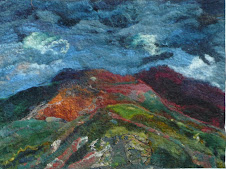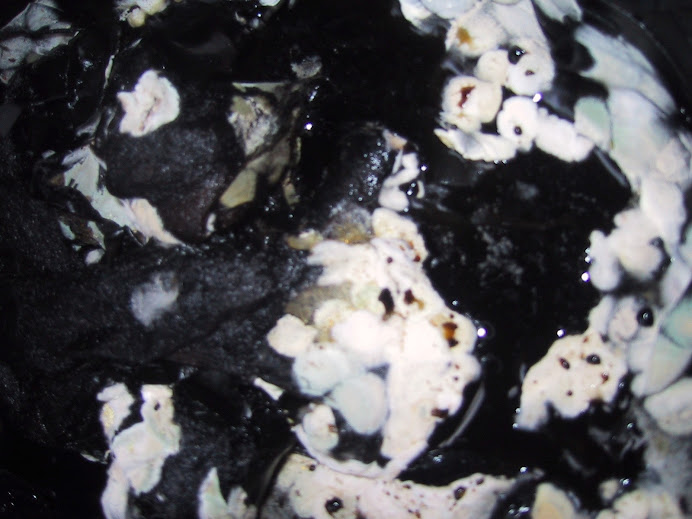It has been such a long time since I wrote in my blog that you might be justified in thinking that I had vanished from the face of the earth but not so! I am here alive and reasonably well. Following on from the previous post was surprisingly daunting, and besides I thought having made the effort to write such a long blog I might as well leave it there to be read for as long as possible.
On February 21st I ran a dyeing workshop for region 11 of the International Felt Makers. It is a while since I have run a dyeing workshop with immersion dyes as opposed to extract dyes apart from in my own studio so I had forgotten the huge amount of preparation involved. I seem to spend days mordanting a variety of wools,silk and such like as well as planning out the day like a military operation with all the baths with their own start and finish times. Dyes were soaked, heated and extracted and then all had to be transported to a hall up the road. In the end the work was worth it, the students seem to have a good day and it all went smoothly apart from my forgetting to strain the brazilwood bath so all the wool samples were tangled up with tiny chips. We did have one or two surprises and one was the rhubarb root bath. I had included rhubarb root because I always classify it as a substantive dye as I thought if I was short of time to mordant I could put in unmordanted fibres. I was surprised to find when researching that Dominique Cardon classified it as a mordant dye despite it being high in tannins. I had forgotten too that Su Grierson had experimented with Rhubarb root and had got a coral red when she soaked the rhubarb root in water with ammonia added for five days. I decided to do that for the workshop and then realised I also had large jam jar with rhubarb root soaking on my studio window sill where I had been sitting forgotten and neglected since last August. The fibres dyed in my rhubarb that had been soaking since last august-these are on the left of the picture - came out a dull soft pink very like the colour of stewed rhubarb.The rhubarb in the workshop came out a very deep mustard yellow almost a gold, added ammonia turned it into a deep brown with red and gold shades shot through the fibres. The fibres on the right were dyed in the exhaust with dash of ammonia added. Both fibres were mordanted with 8% alum,7% cream of tartar
I took some photos of the workshop but they were hasty and came ut looking blurred and poor. -I find taking pics when I am running a workshop is quite impossible.I need a resident photographer I have decided!
Below are the notes I wrote for the workshop
Rhubarb Root
Rheum sp
The rhizome of the garden rhubarb root belongs to the same group of dye plants as docks and sorrels which are described in Dominique Cardon's authoritative book ”Natural Dyes” as the russet dyeing polygonaceae.
Rhubarb originated in Mongolia but is now widespread in temperate climates and is used by Tibetan refuges who also use the leaves, which give oxalic acid, as a mordant and the stems as a ferment for the indigo vat. The rhizome of the ordinary garden root contains complex tannins, the result is a bright mustard yellow dye that a dash of ammonia will turn pink. I have always used this as a substantive dye, that is one that can be used without a mordant, but Dominique Cardon describes it firmly as a mordant dye when it will give orange. It is not often found in the older dye books probably because it was not established in the UK till 1758 (Grierson). However Su Grierson while exploring traditional Scottish dyes experimented with Rhubarb rhizomes a lot and got a range of colours on mordanted yarn from greys, topaz, lake and coral reds and it is a variation on her recipe we used in the work shop
Recipe
Starting 5 days before required
- Use 50% Rhubarb root to WOF (Weight of dry fibres)
- Cover with water
- Add 1 tablespoon of household ammonia/100g
- Leave for Five days
- Put into a dye pot with sufficient water added for the fibres to move freely
- Enter either pre-mordanted and un-mordanted fibres heat till the water steams and hold for an hour
 hour
hour - .Allow to cool
- Rinse fibres
I am now busy getting ready for the next lot of workshops-five in March. Too many really as I still get very tired and still don't feel quite myself. The consultant was spot on when she said
I would need 6 weeks convalescence but it would be three months before I felt quite right. :(
Welcome to all the new followers to my blog.
Helen





















